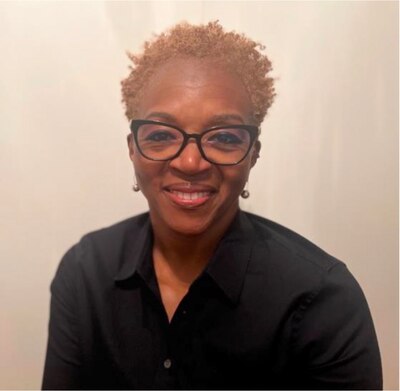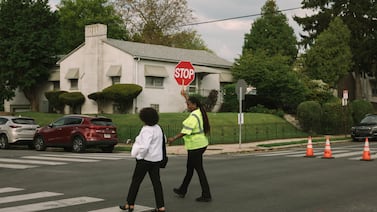Peggy Clark dropped her career as a hair salon owner to become an educator after an interaction with her daughter’s second grade teacher that left her baffled.
“One day, my daughter came home and told me that all the kids that looked like her were in the lower academic groups in her second grade classroom,” said Clark.
Her daughter had been reading before entering kindergarten, and still, she was placed in a lower reading group, composed mostly of Black students, like her.
Clark asked the teacher about her child’s placement at the Ohio magnet school she attended but to no avail. Only after a meeting with the principal was Clark’s daughter moved to another classroom.
Though the student body of the school was diverse, Clark said the mostly white teaching staff did not reflect the student population.
“I think that’s really important,” Clark said. “If kids see someone else who looks like them in different positions modeled for them, they internalize that they, too, can attain those things.”
Clark, now a fourth grade English language arts and social studies teacher at Erma L. Henderson Academy in Detroit Public Schools Community District, has been an educator for nine years. She was recently named a Michigan Collaborative Teacher Leader in a program co-led by the Education Trust-Midwest and Teach Plus, which picks 20 educators across the state to meet with lawmakers, share their classroom experiences, and learn more about statewide education policies.
In the program, Clark is working on a committee focused on equitable school funding. She said her experience as a parent and an educator seeing inequity in schools first-hand informs her work.
“I’ve worked with students in poverty for most of my career,” she said. “Teaching has given me a variety of experiences and I’ve seen the things that students are going through. It made me be more empathetic to those students and realize that instead of just focusing on learning, we need to be wrapping our arms around them and supporting them.”

Was there a moment when you decided to become a teacher?
Teaching is a second career for me. When my daughter was a student, before I became a teacher, I got to see the public education system from an adult perspective. As I was going through the ordeal with her teacher, I began to wonder about what happens to children who don’t have parents who advocate on their behalf. From that moment forward, I wanted to do more to ensure equity for all students.
How do you get to know your students?
I get to know my students by providing them with various opportunities to talk about themselves. I spend the first couple weeks of school engaging them in various games and activities focused on building relationships and getting to know each other. I share personal information and stories about myself to make my students feel more comfortable with sharing about themselves.
I use a variety of get-to-know-you activities so I can reach all of the various types of learners in my class. Many of the activities involve movement and provide students with opportunities to interact with each other. Some of my favorite activities include the games 4 Corners, When the Wind Blows, and Teacher Hot Seat. In addition to classroom activities, I also make it a point to join my students for lunch in the cafeteria, so that I can talk to them and, hopefully, learn some of their interests as they interact with their peers.
Tell us about a favorite lesson to teach. Where did the idea come from?
I do not have a specific favorite lesson, but I do have a favorite lesson delivery method. I enjoy escape rooms, which can be used to teach a wide variety of different topics. I like escape rooms not only because my students enjoy them, but also because they provide the opportunity for students to practice a wide variety of skills that include collaboration, critical thinking, and academic standards. I got the idea of escape room activities from the 10-Minute Teacher podcast and subsequently did more research on them.
The most recent escape room that I used had students use context clues to determine the meaning of words and then place them in puzzles or riddles to identify a code. Once students determined the code, they delivered it to me, the Emoji Queen, to receive the next challenge. My students found the activity to be both challenging and fun.
What object would you be helpless without during the school day?
The object that I would be helpless without during the school day is my smartboard. My smartboard has a touch screen, which provides students with opportunities to take turns manipulating and annotating previously loaded activities or materials. I use a smartboard to guide students through lessons and assignments as I model expectations and my thinking for them. I also use it to guide students through the navigation of and use of various apps and software programs. My smartboard displays timers, videos, choice boards, and anything else that can aid students in their learning.
What’s something happening in the community that affects what goes on inside your class?
Something happening in the community that I think is having the greatest impact on what goes on in my classroom is the obsession with technology. I think that technology has many useful benefits and can provide students with many advantages that I did not have when I was in school. For example, it provides immediate access to dictionaries, translation services, calculators, learning videos, and many other things that can be used to advance the attainment of knowledge.
On the other hand, I think that technology is being overused. When I’m out with my family, I often see other families sitting at a table with everyone’s head buried in a phone or another device. I witness the impact of this lack of human interaction and dialogue in my class in the form of limited vocabulary, lack of critical thinking skills, inappropriate conversation etiquette, attention-span deficits, and writing deficiencies.
There must be a balance of tech and human interaction so that students — at home and school — develop skills important to their future. I do use laptops within my classroom because I want my students to have the ability to navigate various programs on their devices and to use the internet to become independent researchers and designers of fabulous print and video materials.
Tell us about a memorable time — good or bad — when contact with a student’s family changed your perspective or approach.
During my first year of teaching, I called the home of a student who was sleeping a lot during class. As I was speaking with the parent, she shared that they were currently homeless and did not have a stable place to stay. This significantly changed my perspective and approach. I had been thinking that the student was either being lazy or staying up late to play the latest video game. Upon learning about the student’s situation, I realized that I needed to extend more grace to students and spend additional time trying to make them comfortable to share the why behind their actions. Now, I try to listen more and talk to students when they are exhibiting undesired behaviors.
What part of your job is most difficult?
The most challenging, and also exciting part of my job is meeting the needs of every student. I teach a district-mandated curriculum and spend a great deal of time with my students on that content. I also intentionally work with students who are reading below grade level to teach them the necessary foundational skills they might have missed so that they can persevere through a complex text or math problem independently. I believe we must strongly focus in the elementary grades on the development of these foundational skills so students can achieve and thrive in the latter years of school. I also hone in on each student’s needs by meeting with small groups of about six to eight students daily to focus on a particular skill or standard that they may be struggling to master.
What was the biggest misconception that you initially brought to teaching?
The biggest misconception that I initially brought to teaching was that teachers can only impact education from within the walls of their classroom. I now know differently. Through communication with other teachers, I have realized that we share many commonalities when working with diverse students, including building opportunities and policy levers to support our student’s emotional well-being, physical health, nutrition, and learning challenges, to name a few.
My desire to support as many students as possible has led me to Teach Plus, which helps teacher leaders like me advocate for student needs by empowering us to elevate our voices. This year, I’m looking forward to working with a cohort of Michigan teachers to push for changes in the areas of equitable school funding, early literacy, teacher retention and recruitment, transition to post-secondary education, and social-emotional and academic development. As a group, we will advocate for students by making policymakers and other stakeholders aware of the issues important to teachers, students, and communities.
Recommend a book that has helped you be a better teacher, and why.
The book that helped me be a better teacher is “Teach Like a Champion, 2.0″ by Doug Lemov. The author provides classroom management techniques for teachers to use and details specific actionable steps to help them to implement high expectations for students. It includes well-scripted routines accompanied by videos demonstrating how to implement them with students. It remains a resource that I sometimes refer to, and most of the strategies have become ingrained into my daily practice.
For example, one of the techniques from the book is called “Threshold,” which involves greeting students at the door as they enter the classroom so that I can assess how they are feeling to attempt to curtail any future problems or concerns. Another technique is establishing a routine of having students complete a brief 3- to 5-minute task that Lemov refers to as a “Do Now,” allowing me time to take attendance and/or speak with students as needed.
What’s the best advice you’ve received about teaching?
The best advice I’ve received about teaching is to remember to take time for myself. When I first started teaching, I would arrive early and often stay late after the school day ended. I wanted to make sure I was providing my students with the best education that I could. I found myself tired and missing out on something important to me: family time. Since receiving the advice, I still arrive to work early, but I get up even earlier to ensure I’m putting myself first. I go to bed early and try to get a good night’s sleep so I can make it to the gym at about 5 a.m. Sleep and exercise help me to be in the best physical and mental shape possible for both my students and me. Additionally, I meditate, eat healthy foods, and set time limits when I take work home to ensure that I have time to engage in activities with my family and friends.
Hannah Dellinger covers K-12 education and state education policy for Chalkbeat Detroit. You can reach her at hdellinger@chalkbeat.org.







